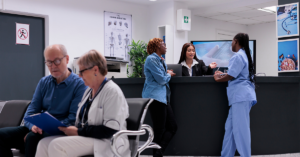Struggles and character-building experiences are the mark of a true leader. In the case of Mede’s Chief Technology Officer, Ping Zhang, it’s a story of constant bootstrapping that brought him to his leadership position today and inspired him to make a meaningful impact on today’s healthcare system. Here’s a preview of Ping’s rags to riches story that influenced his leadership style, along with his recommendations for other health IT leaders, check out his recent HIStalk post:
My journey into technology was a long road. The first 15 years of my life were spent in the Hunan province in rural southern China. My family had no running water, and more often than not, we went to bed hungry.
At five, I started working with my father in the rice paddies. I planted rice seeds while my father manually built rice rows and dug irrigation canals. Everything was done by hand. It wasn’t until I was 11 that I saw my first technological advancement — a tractor — on my way to school.
At age 15, I rode on a train for the first time on my way to college. It was only then that I realized the promise of technology and how it could save my father’s back and hands from the brutal years of manual labor.
My passion for mathematics helped me earn my bachelor’s degree at 19 in China. After the 1989 events in Tiananmen Square, I decided to try to migrate to the United States. In 1990, I landed in Fayetteville, Arkansas with only my bags and a hundred American dollars to pursue my PhD at the University of Arkansas at Fayetteville. My wife followed soon after.
Eighteen months after moving to the US, I had my first experience with the American healthcare system. Early one Friday evening in 1992, my wife suddenly felt a sharp pain in her stomach. We rushed to the emergency room. We waited and waited – and waited some more. Three hours later, she was finally seen by an OB/GYN doctor.
It turned out that she had an ectopic pregnancy. She had been pregnant, but the fertilized egg had become lodged in one of her Fallopian tubes. Two liters of blood had accumulated as she waited for treatment. She had come close to losing her life.
The next day, the doctor cleared her for discharge with a clean bill of health, leaving us with a bill of a few thousand dollars. One of her Fallopian tubes had been torn open and the other had become so clogged with lost blood that it would likely permanently block any egg. We were told the chances of her ever having a child were slim.
The experience was shocking, scary, and life altering. Thankfully, after years of infertility treatments, she was able to give birth to two beautiful boys.
That horrible experience was over 20 years ago, but I still remember it like it was yesterday. Part of the reason is that I have spent many of those past 20 years working within the healthcare system to change it myself. I want to share three key lessons…
To read more about Ping’s tips, visit his full HIStalk post, “Readers Write: From Rice Fields to Big Data.”
Get our take on industry trends
Your EHR’s new favorite teammates
EHRs are truly great at their jobs. They are fundamentally and fantastically equipped to collect data that to the naked…
Read on...10 Strategies for Engaging Providers in Data Dashboards
Payer organizations should be dialed in on data engagement as a key indicator of financial sustainability, successful care delivery, and…
Read on...4 tactics to harness data analytics for patient access engagement and efficiency
As healthcare consumers and regulatory bodies push for more transparency in medical services and transactions, provider organizations are applying greater…
Read on...Proactively predicting ER visit trends with augmented analytics to improve revenues, asset utilization and patient outcomes
Mission critical emergency departments (EDs) are the most valuable revenue generating asset for hospitals. While visits decreased during the pandemic,…
Read on...


